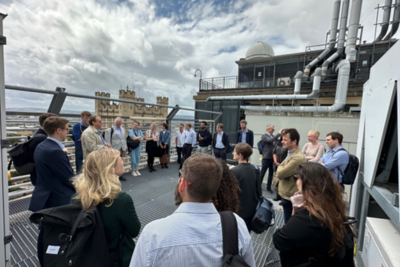University of Bristol hosts the visit of government delegation
A Government delegation from UK Research and Innovation (UKRI), the Department for Science, Innovation and Technology (DSIT), and HM Treasury visited Bristol on Monday 10 July to hear about the University’s Digital Research Infrastructure strategy and to see the new £10m GW4 Isambard 3 supercomputer facility.
Digital Research Infrastructure (DRI) is a key Government focus, and the visit was arranged to discuss key issues about the crucial importance of DRI to many strategically important areas of research and industry in the UK.
The delegation enjoyed a visit to the University’s “Blue Crystal” supercomputer, housed on the top of the Physics Building at one of the highest spots in the city, before getting to meet the University’s Vice Chancellor, Professor Evelyn Welch, and the Pro Vice-Chancellor for Research and Enterprise, Professor Phil Taylor, along with GW4 Director, Dr Joanna Jenkinson.
The discussions included how digitalization underpins the university-wide approach to three major issues: equitable and sustainable health outcomes, net zero and climate change; and the creative and cultural industries.
The delegation also got the chance to visit the site for the recently announced Isambard 3 – a new, TOP500-class supercomputer service from GW4 for AI and high-performance computing – which will allow researchers to push the boundaries of scientific research. Hosting Isambard 3 at the National Composites Centre on the Bristol and Bath Science Park in north Bristol cements the University of Bristol’s leadership position in high-performance computing.
The GW4 Alliance brings together the universities of Bath, Bristol, Cardiff and Exeter. The Isambard 3 supercomputer project is possible thanks to GW4 being awarded £10 million by UK Research and Innovation (UKRI). To deliver Isambard 3 later in 2023, GW4 is teaming up with Hewlett Packard Enterprise (HPE), NVIDIA and Arm.
Professor Simon McIntosh-Smith, Principal Investigator for the GW4 Isambard project and a Professor of high-performance computing at the University of Bristol, has been at the forefront of introducing Arm based technologies for HPC.
Professor McIntosh-Smith said: “It was fantastic to welcome the UKRI delegates to the University, and to get the chance to discuss how Isambard 3 represents the next generation of cutting-edge Digital Research Infrastructure.
“Not only will Isambard 3 enable new kinds of research and innovation in artificial intelligence and scientific simulations, but it will provide a transformational increase in performance, energy efficiency and operational agility.”
Initially hosted by the Met Office to develop more sophisticated weather forecasting and climate prediction modelling, Isambard has also been used to investigate next-generation healthcare and to develop innovations in medicine.
Researchers are running molecular level simulations to understand the mechanisms behind Parkinson’s disease, and to help develop new drugs to treat osteoporosis. Research conducted on Isambard was also vital in the fight against COVID-19, contributing to the design of the vaccines and anti-virals by modelling the virus and how vaccines might work against it.
Since its start in 2017, the GW4 Isambard national HPC service has enabled nearly a thousand people to be trained in advanced computing and simulation techniques all over the world. Isambard 3’s expanded capabilities create the opportunity for new training around advanced AI workloads through tutorials and hackathons.
Employing the latest sustainability techniques and best practice, Isambard 3 is being designed to be one of the most energy-efficient, lowest carbon emission CPU-based supercomputers in the world, with the potential to reuse waste energy to heat surrounding buildings.
It is expected Isambard 3 will be fully installed later this year, with user migration taking place over the winter, ready for use early 2024.

